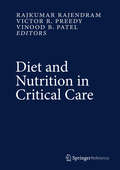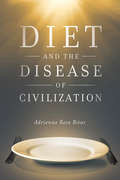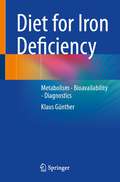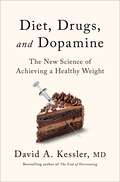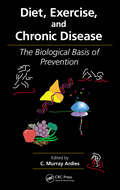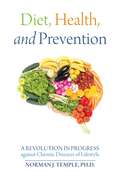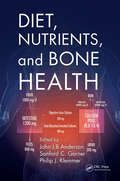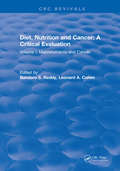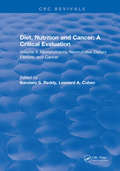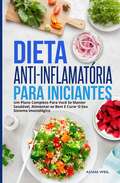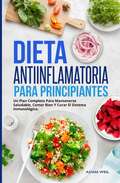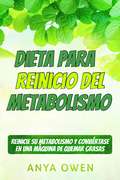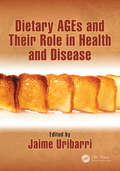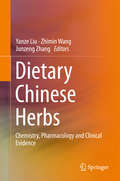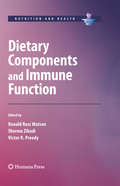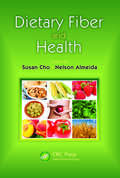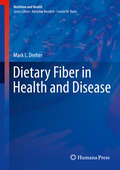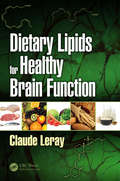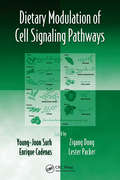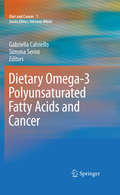- Table View
- List View
Diet Quality: An Evidence-Based Approach, Volume 1
by Victor R. Preedy Vinood B. Patel Lan-Anh HunterDiet quality is a broad term that encapsulates both perceived and actual practices, personal preferences and cultural diversity. Measuring dietary quality can be problematic and includes investigating food types, the number or size of portions or their frequency. Diet quality may also be related to the type of food being ingested, snacking and other eating habits. Manufactured beverages and fast food may also be included as well as microbiological quality and attempts to improve single food items such as meats or vegetables. In this book, Diet Quality: An Evidence-Based Approach, Volume 1 all of the major facets of diet quality in relation to health outcomes are covered. This important new text includes methods for determining diet quality while adopting a holistic approach to impart information on the major areas of concern or knowledge. Chapters link in measurable indices of health such as obesity, pregnancy outcomes, cancer and cancer outcomes, and mortality. This book represents a diverse set of subject matters and seeks to fill a gap in the literature at a time when there is an increasing awareness that well being is associated with the qualitative nature of diets. Contributors are authors of international and national standing and emerging fields of science are incorporated. Diet Quality: An Evidence-Based Approach, Volume 1 is a useful new text designed for nutritionists, dietitians, clinicians, epidemiologist, policy makers and health care professionals of various disciplines.
Diet and Exercise in Cognitive Function and Neurological Diseases
by Akhlaq A. Farooqui Tahira FarooquiDiet and exercise have long been recognized as important components of a healthy lifestyle, as they have a great impact on improving cardiovascular and cerebrovascular functions, lowering the risk of metabolic disorders, and contributing to healthy aging. As a greater proportion of the world's population is living longer, there has been increased interest in understanding the role of nutrition and exercise in long-term neurological health and cognitive function. Diet and Exercise in Cognitive Function and Neurological Diseases discusses the role and impact that nutrition and activity have on cognitive function and neurological health. The book is divided into two sections. The first section focuses on diet and its impact on neurobiological processes. Chapters focus on the impacts of specific diets, such as the Mediterranean, ketogenic and vegan diets, as well as the role of specific nutrients, fats, fatty acids, and calorie restriction on neurological health and cognitive function. The second section of the book focuses on exercise, and its role in maintaining cognitive function, reducing neuroinflammatory responses, regulating adult neurogenesis, and healthy brain aging. Other chapters look at the impact of exercise in the management of specific neurological disorders such Multiple Sclerosis and Parkinson's Disease.Diet and Exercise in Cognitive Function and Neurological Diseases is a timely reference on the neurobiological interplay between diet and exercise on long-term brain health and cognitive function.
Diet and Nutrition in Critical Care
by Victor R. Preedy Vinood B. Patel Rajkumar RajendramFinding all the information necessary to treat or meet the nutritional requirements of patients who are severely ill or establish new protocols has historically been problematic. This is addressed in Diet and Nutrition in Critical Care. This major reference work encapsulates the latest treatments and procedures to meet the dietary and nutritional needs of the critically ill. Where evidence is available this is presented. However, where evidence is absent, the authors highlight this and provide guidance based on their analysis of other available data and their clinical experience. Diet and Nutrition in Critical Care is a three volume set which addresses the needs of all those concerned with diet and nutrition in the critically ill and covers General Aspects, Enteral Aspects, and Parenteral Aspects. Each volume is stand alone and is further divided into separate sections. The Sections in the General Aspects are: General conditions in the severely ill General metabolic effects and treatments Assessment protocols General nutritional aspects Specific nutrients Adverse aspects The next two volumes Enteral Aspects and Parenteral Aspects contain the following sections: General aspects and methods Specific nutrients Specific conditions Adverse aspects and outcomes Comparisons or dual parenteral and enteral support or transitions Preclinical studies The authors recognise the limitations in simplistic divisions and there is always difficulty in categorising treatment regimens. For example, some regimens involve transitions from one feeding protocol to another or the development of co-morbid conditions and in some cases enteral support may be supplemented with parenteral support. This complexity however, is addressed by the excellent indexing system. Contributors are authors of international and national standing, leaders in the field and trendsetters. Emerging fields of science and important discoveries relating to artificial support will also be incorporated into Diet and Nutrition in Critical Care. This volume represents a one stop shop of material related to enteral and parenteral support and is essential reading for those specialising in intensive and critical care, dietitians, nutritionists, gastroenterologists, cardiologists, pharmacologists, health care professionals, research scientists, molecular or cellular biochemists, general practitioners as well as those interested in diet and nutrition in general.
Diet and the Disease of Civilization
by Adrienne Rose BitarDiet books contribute to a $60-billion industry as they speak to the 45 million Americans who diet every year. Yet these books don’t just tell readers what to eat: they offer complete philosophies about who Americans are and how we should live. Diet and the Disease of Civilization interrupts the predictable debate about eating right to ask a hard question: what if it’s not calories—but concepts—that should be counted?Cultural critic Adrienne Rose Bitar reveals how four popular diets retell the “Fall of Man” as the narrative backbone for our national consciousness. Intensifying the moral panic of the obesity epidemic, they depict civilization itself as a disease and offer diet as the one true cure. Bitar reads each diet—the Paleo Diet, the Garden of Eden Diet, the Pacific Island Diet, the detoxification or detox diet—as both myth and manual, a story with side effects shaping social movements, driving industry, and constructing fundamental ideas about sickness and health. Diet and the Disease of Civilization unearths the ways in which diet books are actually utopian manifestos not just for better bodies, but also for a healthier society and a more perfect world.
Diet for Iron Deficiency: Metabolism - Bioavailability - Diagnostics
by Klaus GüntherAround a quarter of the world's population is affected by iron deficiency, and women of childbearing age as well as children and adolescents are considered a particular risk group. This reference book deals with the latest scientific findings concerning the iron supply of the human organism with natural foods. It dispels the misconception that plant iron is less valuable than animal iron by presenting the absorption of iron from plant foods via a newly discovered metabolic pathway. From this, new points of view can be derived for vegetarians and vegans, who until now have belonged to the risk group. Furthermore, it is dedicated to forward-looking possibilities of diagnosing iron deficiency and describes modern concepts for determining the bioavailability of iron in food. New findings on the biochemistry of iron in brain metabolism, the description of the different reference values of the international professional societies and practical advice for special diets, risk groups and age groups as well as cooking recipes with simple information on iron intake complete the work. The book is aimed at nutritionists and medical practitioners, nutrition and food scientists, dieticians, pharmacists and sports scientists.
Diet, Brain, Behavior: Practical Implications
by Robin B. Kanarek Harris R. LiebermanAs the field of nutritional neuroscience has grown, both the scientific community and the general population have expressed a heightened interest in the effect of nutrients on behavior. Diet, Brain, Behavior: Practical Implications presents the work of a diverse group of scientists who collectively explore the broad scope of research in the field.T
Diet, Drugs, and Dopamine: The New Science of Achieving a Healthy Weight
by David A. KesslerFrom the New York Times bestselling author of The End of Overeating comes an illuminating understanding of body weight, including the promise—and peril —of the latest weight loss drugs. <P> The struggle is universal: we work hard to lose weight, only to find that it slowly creeps back. In America, body weight has become a pain point shrouded in self-recrimination and shame, not to mention bias from the medical community. For many, this battle not only takes a mental toll but also becomes a physical threat: three-quarters of American adults struggle with weight-related health conditions, including high blood pressure, heart disease, and diabetes. We know that diets don’t work, and yet we also know that excess weight starves us of years and quality of life. Where do we go from here? <P> In Diet, Drugs, and Dopamine, former FDA Commissioner Dr. David A. Kessler unpacks the mystery of weight in the most comprehensive work to date on this topic, giving readers the power to dramatically improve their health. Kessler, who has himself struggled with weight, suggests the new class of GLP-1 weight loss drugs have provided a breakthrough: they have radically altered our understanding of weight loss. They make lasting change possible, but they also have real disadvantages and must be considered as part of a comprehensive approach together with nutrition, behavior, and physical activity. Critical to this new perspective is the insight that weight-loss drugs act on the part of the brain that is responsible for cravings. In essence, the drugs tamp down the addictive circuits that overwhelm rational decision-making and quiet the “food noise” that distracts us. Identifying these mechanisms allows us to develop a strategy for effective long-term weight loss, and that begins with naming the elephant in the room: ultraformulated foods are addictive. Losing weight is a process of treating addiction. <P> In this landmark book, one of the nation’s leading public health officials breaks taboos around this fraught conversation, giving readers the tools to unplug the brain’s addictive wiring and change their relationship with food. Dr. Kessler cautions that drugs, on their own, pose serious risks and are not a universal solution. But with this new understanding of the brain-body feedback loop comes new possibilities for our health and freedom from a lifelong struggle. Eye-opening, provocative, and rigorous, this book is a must-read for anyone who has ever struggled to maintain their weight—which is to say, everyone. <b>New York Times Bestseller</b>
Diet, Exercise, and Chronic Disease: The Biological Basis of Prevention
by C. Murray ArdiesExercise and diet are key factors in the etiology and prevention of chronic disease. While most books on chronic disease have a decided clinical approach, Diet, Exercise, and Chronic Disease: The Biological Basis of Prevention brings together the latest cellular- and molecular-based research on the etiology of chronic diseases and the impact of var
Diet, Health, and Prevention: A Revolution in Progress against Chronic Diseases of Lifestyle
by Norman J. TempleChronic diseases of lifestyle (CDL), such as heart disease, diabetes, and cancer, are the dominant family of diseases in the USA and across the Western world. These diseases are closely related to an unhealthy lifestyle. The book explores this family of d
Diet, Nutrients, and Bone Health
by Sanford C. Garner Philip J. Klemmer John J.B. AndersonPresenting recent advancements in research findings and the resulting new schools of thought on the physiology of human bone, this comprehensive reference examines information on dietary pattern and specific nutrients in bone health. Written by experts in the areas of nutrition, bone function, and medicine, chapters include research on a variety of
Diet, Nutrition and Cancer: Volume I
by Bandaru S. ReddyThese two volumes bring together a wide variety of studies concerning the role nutrition plays in the etiology of various types of cancer, namely, cancer of the esophagus, upper alimentary tract, pancreas, liver, colon, breast, and prostate. The purpose of each chapter is to provide a critical interpretive review of the area, to identify gaps and inconsistencies in present knowledge, and to suggest new areas for future research.
Diet, Nutrition and Cancer: Volume II
by Bandaru S. ReddyThese two volumes bring together a wide variety of studies concerning the role nutrition plays in the etiology of various types of cancer, namely, cancer of the esophagus, upper alimentary tract, pancreas, liver, colon, breast, and prostate. The purpose of each chapter is to provide a critical interpretive review of the area, to identify gaps and inconsistencies in present knowledge, and to suggest new areas for future research.
Diet, Nutrition, and Fetal Programming
by Victor R. Preedy Vinood B. Patel Rajkumar RajendramThis volume offers the most comprehensive coverage on fetal programming. Chapters are written by authors of international and national standing, leaders in the field and trendsetters. The clinical relevance of the current research is emphasized in each chapter, which also contains key points, key words, and concise summaries for ease of learning. Fetal programming affects conditions in the immediate postnatal period, as well as in later life and adulthood. These conditions include cardiovascular disease, frank hypertension, stroke, dyslipidemia, coagulopathy, increased insulin resistance-metabolic syndrome, type-2 diabetes, leukemia, testicular cancer, prostate cancer, breast cancer, polycystic ovary syndrome, precocious puberty, impaired immune function, renal disease, lung disease, and osteoporosis. Neuropathologies, behavioral and mental deficiencies, schizophrenia, and depression have also been reported in adults who were exposed to nutritional inadequacies in utero. Diet, Nutrition and Fetal Programming provides an overview on the effects of fetal programming on disease, and comprehensive looks at maternal nutrition factors and fetal programming effects on brain and behavior, and physiology and disease. It also provides an in depth look at specific nutrient restrictions and supplements on physiology and disease, the effects of maternal disease on fetal programming, mechanisms of programming, and a special section on the international aspects and policies on fetal programming.
Dieta Anti-inflamatória Para Iniciantes: Um Plano Completo Para Você Se Manter Saudável, Alimentar-se Bem E Curar O Seu Sistema Imunológico
by Adam WeilVocê está sofrendo de uma inflamação que piora a cada dia? Você está procurando uma maneira simples e totalmente natural de melhorar a sua saúde, perder peso e reduzir a inflamação? Se isso se identifica como você, continue lendo! Independentemente de quem você seja e o que deseja realizar, o aprendizado sobre como combater a inflamação é um processo igual para todos. Este livro irá ajudá-lo(a) a entender tudo o que você precisa saber sobre uma dieta anti-inflamatória, incluindo os benefícios e desafios de utilizar esta nova dieta; e eu irei lhe fornecer um processo passo a passo para utilizar a dieta anti-inflamatória em sua vida, com algumas dicas práticas e truques que você poderá colocar em uso imediatamente. Nestas páginas, você descobrirá: O significado da inflamação Como a inflamação é medida Como você pode reduzir sua inflamação Alimentos anti-inflamatórios que você pode ingerir Os benefícios ao longo da vida de uma dieta anti-inflamatória E MUITO MAIS! Não importa quão jovem ou velho(a), inexperiente ou experiente, ou que nível de educação você tenha, este livro será capaz de ajudá-lo(a) a fortalecer a sua compreensão sobre uma dieta anti-inflamatória para que você possa utilizá-la em sua vida diária para atingir os objetivos que deseja alcançar. Com a ajuda deste livro, você aprenderá tudo o que há para saber sobre inflamação, suas causas e perigos. Depois de aprender tudo sobre a inflamação, os leitores aprenderão sobre os alimentos anti-inflamatórios, seus nutrientes e como adicioná-los à dieta anti-inflamatória para prevenir e reduzir a inflamação. Se você estiver pronto(a) para assumir o controle e aprender o que uma dieta anti-inflamatória pode fazer para melhorar sua vida, não procure mais. Não perca mais um minuto, role para cima e clique em "COMPRAR AGORA" para começar hoje me
Dieta Antiinflamatoria Para Principiantes: Un Plan Completo Para Mantenerse Saludable, Comer Bien Y Curar El Sistema Inmunológico.
by Adam WeilLa inflamación es la causa de varias dolencias y, si no se maneja adecuadamente, puede provocar la muerte. Existen varios tratamientos administrados por expertos y médicos para la inflamación. Una dieta antiinflamatoria es la mejor y la más eficaz entre ellas. En este libro, aprenderá todo lo que hay que saber sobre la inflamación, los tipos de enfermedades que puede provocar, sus causas y su tratamiento. Encontrará los mejores alimentos inflamatorios y la mejor manera de utilizarlos para crear su propio menú antiinflamatorio. ¿Sufre de inflamación que empeora cada día más? ¿Está buscando una forma sencilla y totalmente natural de mejorar su salud, perder peso y reducir la inflamación? Si esto te suena, ¡sigue leyendo! La inflamación es la causa de varias dolencias y, si no se maneja adecuadamente, puede provocar la muerte. Los expertos y los médicos brindan varios tratamientos para la inflamación, y una dieta antiinflamatoria es la mejor y la más efectiva. En este libro, aprenderá todo lo que hay que saber sobre la inflamación, los tipos de enfermedades que puede provocar, sus causas y su tratamiento. Encontrará los mejores alimentos inflamatorios y la mejor manera de utilizarlos para crear su propio menú antiinflamatorio. Independientemente de quién sea usted y de lo que quiera lograr, aprender a combatir la inflamación es igual para todos. Este libro lo ayudará a comprender todo lo que necesita saber sobre una dieta antiinflamatoria, incluidos los beneficios y desafíos de utilizar esta nueva dieta, y le proporcionaré un proceso paso a paso para utilizar la dieta antiinflamatoria en su vida con algunos consejos y trucos prácticos que puede poner en práctica de inmediato.
Dieta para reinicio del Metabolismo: Reinicie su Metabolismo y Conviértase en una Máquina de Quemar Grasas
by Anya OwenResumen del libro La dieta de reinicio corporal tiene como objetivo ayudar en la pérdida de peso con ejercicios ligeros y planes de dieta baja en calorías durante quince días. La dieta se divide en 3 fases de cinco días cada una. Cada fase tenía un patrón particular de dieta y rutina de ejercicios. Necesita consumir alimentos cinco veces al día, comenzando desde la primera fase, que consiste principalmente en batidos y progresando a alimentos más sólidos en la segunda y tercera fases. No existe un criterio de valoración oficial de la dieta después de los primeros quince días para perder y mantener el peso. Los hábitos y rutinas formados durante quince días deben mantenerse durante toda la vida. En este libro aprenderá: ✓ ¿Cómo reiniciar tu cuerpo? ✓ Ciencia detrás del reinicio del metabolismo ✓ Recetas para batidos y ensaladas ✓ ¿Qué tipo de alimentos debería elegir? ✓ Nutrientes que necesita y cómo obtenerlos ✓ ¿Por qué la gente come emocionalmente? ✓ La neurociencia de las sustancias químicas cerebrales y los alimentos como recompensa. Incluye deliciosas recetas para aumentar el metabolismo como: ★ Batido verde ★ Batido de fresa y plátano ★ Ensalada de salmón y cítricos
Dietary AGEs and Their Role in Health and Disease
by Jaime UribarriOf the many dietary factors associated with inflammation and oxidative stress, a specific group are food-derived pro-inflammatory and pro-oxidant compounds, so-called advanced glycation end products (AGEs). While AGEs have been recognized as factors in the pathogenesis of diabetic complications, the importance of AGEs of dietary origin as a factor in human disease is of more recent concern. This book presents data from the past two decades on the role of AGEs in causing chronic disease. It starts by defining the compounds passing through all the clinical diseases that have been associated with them and finishes by offering different therapeutic options to deal with the problem.
Dietary Chinese Herbs
by Yanze Liu Zhimin Wang Junzeng ZhangThis work presents up-to-date information on chemical, pharmacological, clinical studies and historical uses of common dietary Chinese herbs. Authored by native experts in the field, the reader is introduced to each herb with a brief chronological review of Chinese literature on dietary herb uses, with chapters dedicated to each selected herb including color photos for each herb. In addition, Chinese characters as well as the Latin botanical name indices, and chemical structures for the known active compounds are also provided. The clear layout examines the health benefits that have been studied for centuries, including current clinical and toxicological data. A wide range of Traditional Chinese Medicine (TCM) herbs are investigated for their suitability into daily diets for maintaining general wellness or disease prevention. In the past decades, natural health products, dietary supplements, functional foods, or nutraceuticals have emerged in the West due to the increasing demand for non-pharmaceutical healthcare products. Traditional Chinese Medicine disease prevention and treatment incorporates the use of foods, and herbal medicine in an integrated manner, and thus the dietary Chinese herbs in used in TCM for thousands of years could be sources for developing new, effective, and safe ingredients to capture the rapidly expanding opportunity in the global market place.
Dietary Components and Immune Function
by Victor R. Preedy Ronald Ross Watson Sherma ZibadiDietary Components and Immune Function focuses on immune modulation, immune mediated disease resistance, immune changes due to AIDS, immune modulated cancer therapy, and autoimmune diseases as modified by dietary supplement, bioactive foods and supplements. The potential value of such approaches in maintaining wellness and preventing disease are addressed by examining their effects in vitro and in vivo on innate and adaptive immune responses. Emerging fields of science and important discoveries relating to early stages of new nutriceuticals in cancer prevention, prior to clinical trials are also covered. This volume represents a single source of material related to nutriceuticals and their constituents as they relate to cancer therapy and prevention. As such the book will be essential reading for nutritionists, pharmacologists, health care professionals, research scientists, cancer workers, pathologists, molecular or cellular biochemists, physicians, general practitioners as well as those interested in diet and nutrition in disease resistance via immune regulation.
Dietary Fiber and Health
by Susan S. Cho Nelson AlmeidaAdequate fiber in the diet is essential for maintaining gastrointestinal and cardiovascular health and for weight management and glycemic control. But a majority of people in developed countries fall short of their recommended daily intake. Designed for product developers, nutritionists, dietitians, and regulatory agencies, Dietary Fiber and Health
Dietary Fiber in Health and Disease
by Mark L. DreherThis newest addition to the Nutrition and Health series is a comprehensive, yet portable, guide to the use of dietary fiber for the management of health and disease. Dietary Fiber in Health and Disease covers all sources of dietary fiber with a focus on preventing and managing chronic diseases. Each chapter contains a careful analysis with many figures and tables of the most recent human dietary fiber studies and includes specific recommendations on the fiber types and intake levels required to prevent and manage chronic disease and improve health. Additionally, physicians, dietitians, nurses, nutritionists, pharmacists, food industry scientists, academic researchers and educators, naturopathic doctors, and other health professionals will be drawn to the practical, ready-to-use information and coverage of subjects such as fiber in gastrointestinal health and disease, fiber in cancer prevention, fiber in Type 2 Diabetes, and fiber in body weight and composition. Dietary Fiber in Health and Disease will be of interest to physicians and other healthcare professionals in many different specialties, including general practitioners, oncologists, endocrinologists, and other practitioners looking to implement dietary advice as part of the patient treatment plan.
Dietary Interventions in Autism Spectrum Disorders: Why They Work When They Do, Why They Don't When They Don't
by Kenneth Aitken'Given the increased interest in the relationship between diet and autism spectrum conditions, this is a timely publication which is both thorough and balanced in content. Parents and professionals alike will find this book of use by virtue of Ken's meticulous reviews of current scientific evidence for a variety of diets combined with practical advice on the application of such interventions.' - Dr. Paul Whiteley, Autism Research Unit 'Dr. Aitken provides a timely synthesis of diet interventions in autistic spectrum disorders set within a framework of historical and political references. This informative work offers invaluable assistance to the wider clinical team, further enabling effective support and guidance to the ASD community in its quest for a healthy future.' - Rosemary Kessick, former CEO of AiA (Allergy Induced Autism) Research in autism increasingly indicates the existence of different forms of the condition, and the possibility of dietary interventions having a positive effect on symptoms and behaviours associated with autism. The author explores the main dietary approaches that have been advocated in ASD. For each approach, the author explores the potential benefits; evidence for and against the diet and its relation to different genetic conditions; and information, where available, on relevant publications, web resources and support groups. The author proposes an approach, the Simple Restriction Diet (SRD), which he describes in detail, explaining how to implement this approach and how to use it to work out whether a dietary approach is of benefit. This book will be a valuable resource for families, individuals and professionals wishing to understand and explore the possibilities of dietary interventions and the benefits they can have for those on the autism spectrum.
Dietary Lipids for Healthy Brain Function
by Claude LerayOur brain is recognized by all specialists as the most complex entity created in nature. Regarding the extraordinary capacities of its functioning, still incompletely known, the control of the brain by our dietary lipids may seem very improbable to many people. Yet, research has shown that an imbalance in the intake of essential fatty acids is related to conditions as prevalent as depression, bipolar disorder and schizophrenia. Research on psychological disorders including attention deficit hyperactivity disorder, autism, aggressiveness and suicidal behavior are discussed in this text. Several neurodegenerative diseases, such as Alzheimer's, Parkinson's and multiple sclerosis are also explored. Several observations prove that not only are omega-3 fatty acids actively involved in maintaining the noble functions of our brain, but other lipids, including cholesterol, liposoluble vitamins (A, D and E) and some carotenoids play roles as well and are presented in this book. Dietary Lipids for Healthy Brain Function focuses on this important research for human health. This book brings readers, doctors, dietitians and nutritionists arguments that could improve brain development in young people, prevent many nervous diseases and slow down the age-related decline of higher brain functions. This book provides helpful information to improve health in the young as well in the old, using practical and personalized recommendations for preventing and treating nervous pathologies. Features: • Focuses on the importance of dietary lipids on the proper brain functioning. • Provides relevant references demonstrating the efficiency of dietary lipids to maintain a healthy brain. • Introduces lipid sources and describes their roles by lipid groups in behavior issues and various chronic nervous diseases.
Dietary Modulation of Cell Signaling Pathways (Oxidative Stress and Disease)
by Zigang Dong Enrique Cadenas Lester Packer Young-Joon SurhA consequence of rapid progress in the science of nutrigenomics and nutrigenetics is the substantial accumulation of data covering nutrienal modulation of gene expression at the cellular and subcellular levels. Current research is increasingly focused on the role of nutrition and diet in modifying oxidative damage in the progression of disease. Die
Dietary Omega-3 Polyunsaturated Fatty Acids and Cancer
by Simona Serini Gabriella CalvielloDietary Omega-3 Polyunsaturated Fatty Acids and Cancer provides all the latest information on the possible benefits of omega-3 polyunsaturated fatty acids (PUFAs) against a wide series of cancers. Several influential scientists in this field have contributed to make this book unique amongst the others published so far in this field. The chapters give detailed information about the results obtained in this field through experimental studies conducted on both animals and cultured cells, as well as through human intervention trials and epidemiological observational studies. This book represents an important tool for researchers working in nutrition and oncology, since it collects all the knowledge about omega-3 PUFAs and cancer, even the most recent, in a single publication. For the first time controversies among the different studies are also covered with great detail in this book. The book enables physicians to clearly understand on a scientific basis if their oncologic patients or patients at risk of cancer could actually benefit from a diet enriched in omega-3 PUFAs or from a dietary supplementation with these fatty acids. The book represents also a good resource for ordinary individuals as well as cancer patients to learn more about omega-3 PUFAs and understand how these dietary components may affect cancer growth.


